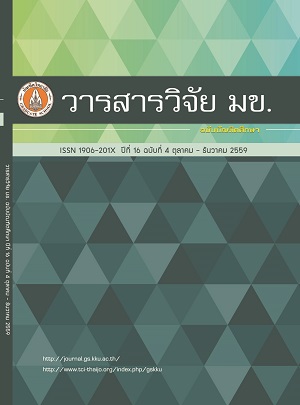การศึกษาเปรียบเทียบการใช้ข้อมูลดาวเทียมเรดาร์แซท-2 หลายช่วงเวลาที่รับส่งสัญญาณ โพลาไรเซชันแบบ HH และแบบ VV เพื่อประเมินพื้นที่ปลูกข้าวนาปรัง (A Comparative Study of Using VV and HH Polarization of Multi-temporal RADARSAT-2 Imagery to evaluate Off-seasonal
Keywords:
เรด้าห์แซท-2 (RASARSAT-2), ข้าวนาปรัง (Off-sensonal rice paddies) ซัพพอร์ตเวกเตอร์แมชชีน (Support Vector Machine)Abstract
วัตถุประสงค์ของานศึกษานี้มีเพื่อจำแนกข้อมูล RADARSAT-2 แบบหลายช่วงเวลาโดยเปรียบเทียบผลการจำแนกระหว่างข้อมูลแบบ HH polarization และข้อมูลแบบ VV polarization เพื่อที่จะพิจารณาศักยภาพในการประเมินพื้นที่เพาะปลูกข้าวนาปรังในเขตพื้นที่น้ำท่วมซ้ำซาก โดยเทคนิคการจำแนกแบบซัพพอร์ตเวกเตอร์แมชชีน (Support Vector Machine, SVM) ได้ถูกนำมาใช้เป็นเครื่องมือในการศึกษาครั้งนี้ และสำหรับชุดแต่ละข้อมูล polarization ในการศึกษานี้ เป็นข้อมูลภาพถ่าย RADARSAT-2 หลายช่วงเวลา โดยใช้ทั้งสิ้น 3 ช่วงเวลาคือ ช่วงเริ่มต้นเพาะปลูก ช่วงข้าวตั้งท้อง และช่วงหลังเก็บเกี่ยว ซึ่งจะถูกมาผสมกันเพื่อใช้ในการจำแนก พร้อมกันนี้ในการตรวจสอบความถูกต้องของการจำแนกนั้น การศึกษาวิจัยนี้ได้ใช้ข้อมูลภาคสนามที่ดำเนินการเก็บข้อมูลในช่วงเวลาเดียวกันกับที่ดำเนินการกวาดภาพ (in-situ ground truth) ซึ่งผลการศึกษาได้ชี้ให้เห็นว่า เมื่อนำไปเทียบกับข้อมูลสำรวจภาคพื้นดิน พบว่า การใช้ข้อมูล RADARSAT-2 ที่รับส่งสัญญาณแบบ HH-Polarization ให้ความถูกต้องในการจำแนกพื้นที่เพาะปลูกข้าวนาปรังที่สูงถึงร้อยละ 80 ในขณะที่ ข้อมูลแบบ VV-Polarization นั้นมีความถูกต้องในการจำแนกเพียงร้อยละ 50 จากความแตกต่างอย่างมีนัยสำคัญนี้ ได้ชี้ให้เห็นว่า หากพิจารณาในมิติของการวิเคราะห์ข้อมูลแบบ single polarization แล้วนั้น การใช้ข้อมูลภาพดาวเทียมแบบ SAR ที่รับส่งสัญญาณ HH-Polarization จะมีความเหมาะสมมากที่สุดในการจำแนกข้าวนาปรัง ซึ่งมีประโยชน์อย่างยิ่งต่อการนำไปประยุกต์ใช้ในอนาคต
The aim of this study is to classify multi-temporal RADARSAT-2 data by comparing the classification results obtained from a dataset of HH-polarization and a dataset of VV polarization in order to evaluate the potential for assessing the off-seasonal rice paddies in flood-prone area. For the comparison between HH and VV polarization SAR data, we employed the support vector machine as a tool for classification. In each polarization dataset, we used a combination of the RADARSAT-2 imagery acquired at the beginning, flowering, and harvesting stages for the classification and subsequently, employed in-situ ground truth data as a reference dataset for evaluation of the classification accuracy. The results indicated that the HH polarization dataset can be used to produce the off-seasonal rice paddies map with the accuracy of 80 percent which is higher the accuracy of 50 percent for the VV polarization dataset. From the substantial difference in the classification accuracy, it indicated that the use of HH polarization for classification of off-seasonal rice paddies is more powerful than the use of VV polarization significantly. Consequently, in aspect of using the single polarization, the results of this study demonstrated the use of SAR data with HH polarization is the most appropriate for classification of the off-seasonal rice paddies.



